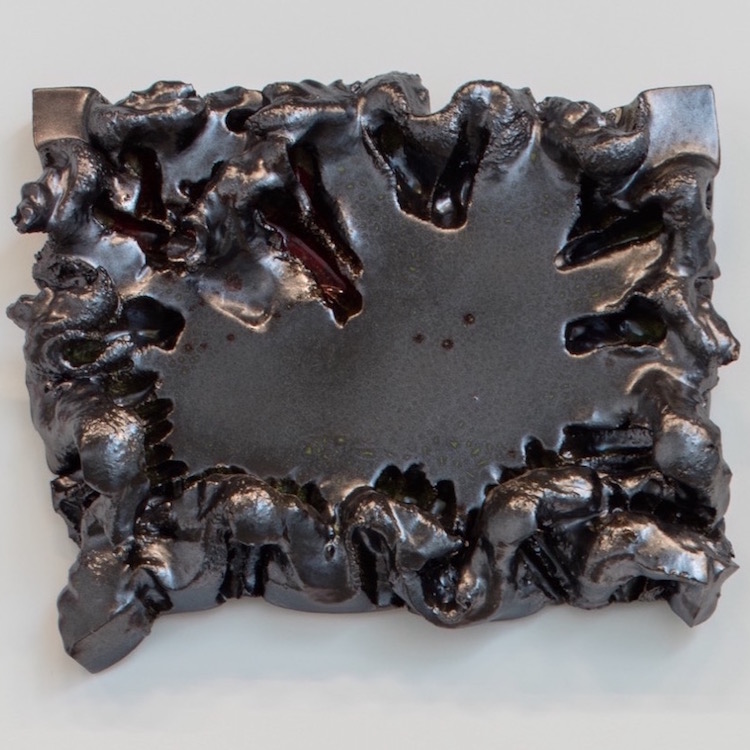LOS ANGELES — Mai-Thu Perret just wrapped up her latest exhibition Féminaire at David Kordansky Gallery (May 19 – July 1, 2017). Her sculptures, ceramic works, performances and texts exist at the intersection of contemporary culture, art historical insight and visceral materiality.
Featured image: Mai-Thu Perret, The red disk fills the universe, 2017, glazed ceramic, 16 1/2 x 21 1/4 x 4 1/4 inches
In Féminaire, Perret explores (and generates) feminist narratives and counter-narratives that cast the role of the art object in new light, introducing utilitarian, symbolic and even mystical possibilities in contexts that are often limited to formalist readings.
Féminaire consists primarily of two bodies of work: a monumental installation of figurative sculptures positioned on a single plinth and a gridded wall arrangement of dozens of ceramic wall pieces. These distinct groups of objects are positioned at either end of the gallery, creating a showdown of competing geometries whose gravity and imposing presence are reminiscent of political monuments and spiritual architecture.

Wall hangings

Mai-Thu Perret, The mind’s eye is as bright as the moon, 2017, glazed ceramic, 15 3/4 x 21 x 4 1/4

Les guérillères opposite wall hangings
The title of the figures, Les guérillères, is borrowed from a 1969 novel by Monique Wittig that tells the speculative story of a war waged by women to take control of society. Its militant protagonists find echoes in Perret’s sculptures, which are also informed by the YPJ, a real-world female militia that has been fighting in the ongoing Syrian civil war.
The figures are constructed as three-dimensional collages, and the artist makes use of her entire repertoire of materials, including glazed ceramics, steel, papier-mâché, wicker, and bronze, as well as found elements like synthetic hair and clothing.

Les guérillères

Les guérillères opposite wall hangings
The sculptures stand and sit in various positions of waiting and repose, actively pensive and patient. Many of them carry guns, and in one case a ceramic dog lies nearby on a wool blanket. Warriors at rest, far from home but resonant of domestic textures, they are reminders that war extends beyond the battlefield into every facet of life, and that in armed conflicts, culture is just as contested as territory.
Perret evokes both the formality of battle memorials and an archaic sense of ceremony by placing the sculptures together on a chest-high base with a sloping front-side. Like mannequins or cyborgs, they broadcast an uncanny, silent gaze that implicates the viewer in their world; but because they are in fact modeled on the forms and faces of the artist’s friends, they deny retreat into purely fictional anonymity. As in the work of relevant predecessors Edward Kienholz and Paul Thek, Perret’s art conjures the intensity of living beings with tangible bodies.

Immediate physicality is also a defining feature of the ceramic wall works that hang opposite the figures. Hung in a grid-like arrangement, they too have been configured so that each object functions both on its own and as part of an overarching totality. Feelings of transcendent universality, specifically the historic appeals to spirit of geometric abstraction, are presented as not only coexistent with, but inseparable from human passions and particularities.

Wall hangings
Beginning with uniform rectangular slabs, Perret uses her hands to distort the material into torqued, unpredictable shapes; the depth and variation of applied glazes accentuate their contours and dimensional relief. Each therefore records a clearly articulated interaction between the artist’s body and the clay that absorbs her actions. As a material with implied connections to the body, both in terms of its inherent malleability as well as the vessels it has been used to create for millennia, the clay offers an alternative (if less explicit) mode of figuration when seen alongside the sculptures that stare back from across the room. At the same time, with their nuanced colors and hanging relationship to the wall, these works also find Perret engaging in conversations commonly associated with painting.

Mai-Thu Perret, Stand on the crest of a high, high peak; walk the bottom of the deep, deep sea, 2017, glazed ceramic, 17 x 21 x 4 1/2 inches
An image-based screen-print endows the physical and formal issues raised throughout the exhibition with the suggestion of a narrative framework. For such works, Perret typically borrows from literary and philosophical sources, but also generates her own Dadaist interventions. This enigmatic print, evocative of a page from a book or a poster announcing a performance, also emphasizes the circular nature of her practice: at the beginning of her career, the artist composed a fictional narrative entitled The Crystal Frontier that documents the activity of women in a separatist utopian community. The objects in Féminaire can be seen as elements in an exploded version of this foundational text, and the evolution of Perret’s practice can be understood as a circular process that challenges the dominant linearity of prevailing historical models.
Text from David Kordansky Gallery.

Wall hangings

Wall hangings
Do you love or loathe these works of art from the worlds of contemporary ceramic art and contemporary ceramics? Share your thoughts in the comments.

Love it. The earthiness of it-just beautiful.
I love this work. It seems to me as if the figures are watching the 2 dimensional signs on the wall, media. becoming still and 2 dimensional themselves waiting for the implied threat to manifest.The wall pieces seem to be made with their own minds. An interaction. Each person has a unique stance, calm and filled with some secret power.(to borrow the phrase from Lorde.)